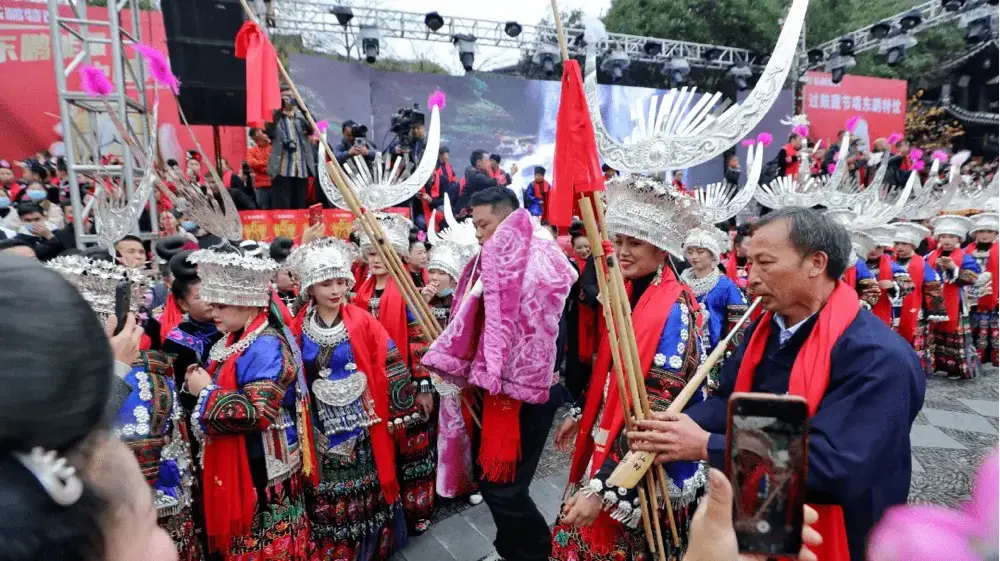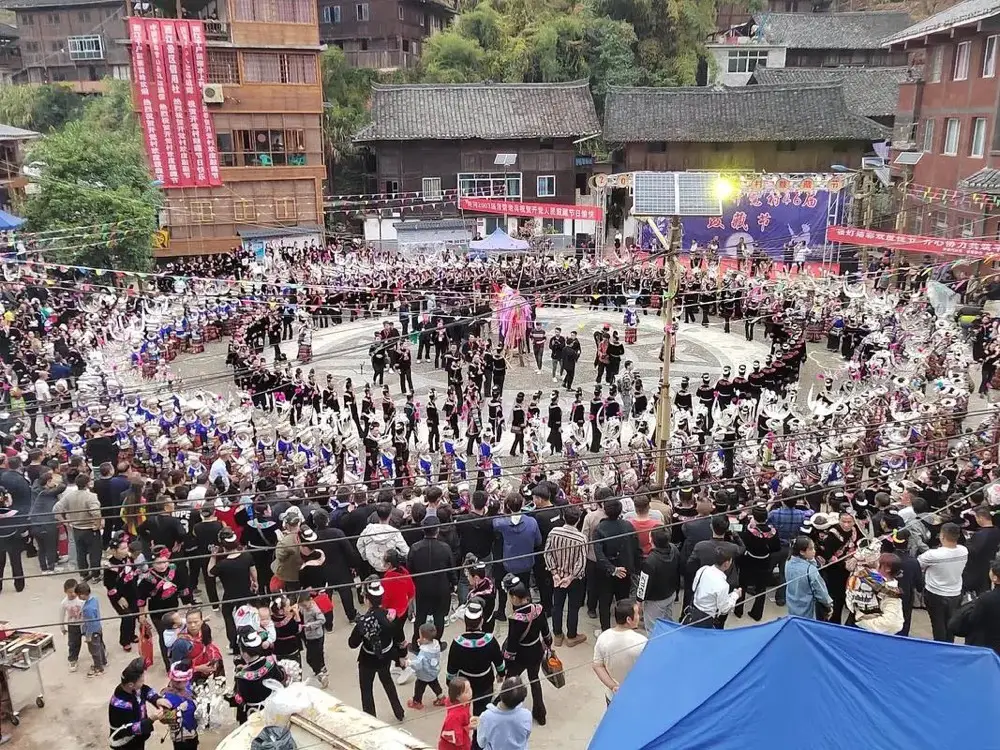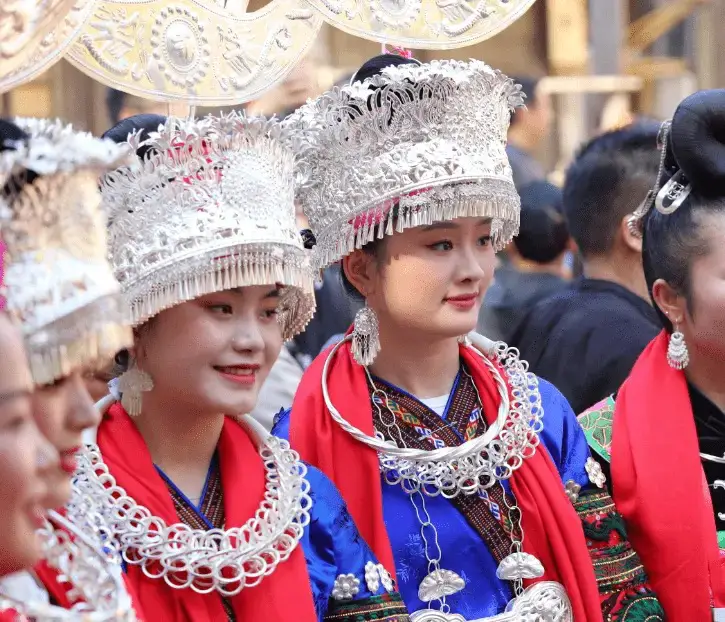“Gucang Festival,” also known as “Eating Gucang,” “Eating Gucangzang,” or “Ci Niu,” is the most solemn ancestral worship ceremony among the Miao and Dong ethnic groups in the southeast of Guizhou and the northwest of Guangxi. The festival is organized by the Gucang heads of various Miao surnames and is generally held between villages or settlements with close historical ties. There are distinctions between small and large Gucang festivals. The small Gucang festival is held annually, usually during the early spring or the autumn after the farming season, where villages slaughter pigs and cattle, invite relatives and friends to gather, and engage in activities such as bullfighting and playing lusheng (a reed-pipe wind instrument). The large Gucang festival is generally held every 13 years, with the hosting village acting as the host.
Origin of the Festival
Legend 1
This ancient ancestral worship ceremony is recorded in the creation songs of the Miao people because the Miao people have only language and no writing, and they excel in singing and dancing, so songs have become the best way to record for the Miao people. The lyrics describe the maple tree as the tree of life for all things. When this tree of life was cut down by the goddess Niuxiang in ancient times, its roots turned into loaches, its trunk into bronze drums, its branches into doves, and butterflies grew in its heart. The butterfly mother laid twelve eggs, becoming the mother of twelve eggs. The butterfly mother incubated the eggs for three years, hatching eleven of them, including Thunder God, ghosts, dragons, snakes, tigers, leopards, wolves, Yongye (the earliest man), Niye (the earliest woman), etc. However, one egg remained unchanged after three years of incubation. The butterfly mother had to ask for help from the storm. The storm blew the egg off the cliff, and when the eggshell cracked open, a small calf emerged. The calf resented the butterfly mother for not hatching it personally and caused the butterfly mother’s death out of anger. Yongye and Niye used the calf to plow the fields, but they never had good harvests. The gods told Yongye and Niye that because the large Gucang bull killed the butterfly mother, the fields were not yielding good crops. Only by slaughtering the large Gucang bull and worshiping the butterfly mother could they obtain a bountiful harvest. Yongye and Niye slaughtered the bull to worship the butterfly mother, and immediately ushered in a bumper harvest. This is one of the legends of the origin of the “Gucang Festival.”

Legend 2
In ancient times, there were two sisters in the Miao family, beautiful, kind, diligent, and intelligent. The older sister was named ‘Ben’ (Miao language: Flower), and the younger sister was named ‘Geng’ (Miao language: Insect). One day, the two sisters went to the mountains to gather firewood and were targeted by two tigers. The tigers transformed into two young men and lured the sisters into the mountains, where they were eaten. The whole village was in deep sorrow. Their father and brother devised a plan to catch and kill the tigers, and at the same time, they closed the village gate, slaughtered a small Gucang bull, and invited everyone to eat beef, warning them not to be deceived again. This is the legend of the Gucang Festival.
Conditions for Emergence
The emergence of the “Gucang Head” must first meet the following conditions: first, both husband and wife are healthy and have children; second, both parents are alive; third, they have good character and reputation; fourth, they have economic conditions above average. In the whole village, many young men are nominated as candidates for Gucang heads. In this way, only the wise and capable “Gou Heng” (Miao: Gucang master) is invited to decide on the Gucang head using the method of divination.
Festival Process
Preparation for the Activities
In preparation for the Gucang Festival, households in the eating Gucang village feed cattle and prepare for the festival one to two years in advance. Some families raise 2-3 head of cattle, while others share one. Families, especially young women, prepare clothing, silver jewelry, and all households compete to prepare wine, meat, fireworks, red decorations, and other gifts. Young women also prepare silk threads, cloth shoes, and other items. The main village sends verbal or written invitations to guests one or two months or half a year before the festival, and invites them again just before the festival. They also erect archways made of fish vines at the entrances and exits of the bullfighting arena. The day before the festival, guests lead the bulls into the village, carrying meat, wine, and colorful gifts, and enter the village amidst the sound of lusheng and firecrackers. The main village also welcomes them with lusheng and firecrackers, and holds a ceremony to pay respects to the gods. During the ceremony, sentries are stationed at the village’s entrances and exits to prevent anyone from entering. The bullfighting activities usually last for 3 to 4 days. On the first day after breakfast, young men and women dressed in their best enter the bullfighting arena to watch the bullfighting without interference. On the second day in the morning, most of the bulls involved in the fight are slaughtered. The organs of the slaughtered bulls are used to offer sacrifices to heaven, earth, ancestors, and pray for bumper harvests, prosperity of livestock, and local peace. During the festival, anyone who comes to watch the bullfighting and stomp their feet is considered an honored guest, and singing and drinking continue day and night. During the slaughter of pigs and worship of ancestors, the Gucang heads select 12 respected elders from the village, including one young and beautiful woman. These elders form a sacrificial team, and it is very significant that one of them is a young and beautiful woman who arranges all the activities related to the festival. When slaughtering pigs and worshiping ancestors, the Gucang head’s family slaughters their pig first, and then the pigs of other families are slaughtered one after another after the Gucang heads conduct their respective rituals. The slaughter of the Gucang head’s pig is a very regulated and complex process with many rituals. A large trumpet-shaped structure woven from freshly cut wood and bamboo is constructed, and then six young men sit precariously inside it while being carried by more than thirty people. The elders lead the way, followed by lusheng players. In the narrow path, they sway and jump toward the Gucang head’s house, and when they arrive, they release the people inside the structure, then put the Gucang head’s pig into it and carry it away. Only one pig can be carried at a time, and the six pigs are carried away and placed in a new enclosure multiple times. Afterward, the shamans gather around them and recite incantations before inserting a sharpened stick into the pig’s heart to kill it. It is a local custom not to scald the pig with hot water but to burn its skin with rice straw fire. The scene of burning pigs in the entire village looks like an ancient battlefield

. The slaughter of cattle and worship of ancestors is even more thrilling. It is scheduled to take place at three o’clock in the early morning, with crowds of people and torches illuminating the surroundings. The place for slaughtering cattle is two large sturdy wooden stakes tied together in an X shape, deeply buried underground at both ends. The bull is surrounded by a large crowd of people, and its head is placed on top of the X shape. Then, the owner of the bull or relatives such as cousins hold an axe and fiercely strike the bull’s head several times. The bull, without any resistance, immediately dies without a sound. Then, the owner quickly pulls out the bull’s tongue and inserts a sharpened stick prepared in advance into the middle of the tongue. It is said that after the bull dies and goes to the underworld, when the King of Hell asks how it died, without its tongue, it cannot explain what happened in the mortal world. After the slaughter is complete, the bull’s head is cut off and arranged in a long row in the center of the slaughterhouse as an offering to the ancestors. Each household cooks a piece of pork and takes it to a small wooden house in the village to offer it. This small wooden house is the sacred shrine of the ancestors of the village. The customs here are very special. Incense and paper money are never burned during festivals or funerals, and no graves are left for the dead. However, there is a great interest in setting off firecrackers, and the sound of firecrackers never stops for three days during the festival.
Formal Procedure
The general procedure of the Gucang Festival is as follows: In the first year, five capable married men are selected by the people as Gucang heads. In the second year, under the leadership of the Gucang heads, cattle are purchased, and tasks such as receiving drums, waking drums, and making single drums are completed. Receiving drums means moving the drums from the previous first drum head’s house to the new first drum head’s house before the ancestor worship ceremony. A grand ceremony is held when receiving the drums. The five drum heads all participate, with singers singing along the way, followed by countless followers, making the scene solemn and lively. Waking drums means going up the mountain to turn over the single drum stored in the grottoes to inform the ancestors that the slaughter of cattle and worship of ancestors are about to take place. Making single drums means making a single drum for each ancestor worship ceremony. When the time comes, the drum heads select some people to go up the mountain, hold a respectful ceremony at the selected tree, and then cut down the tree. They carry the tree segment to the edge of the village, where the crowd beats gongs and drums to welcome it into the village and place it in a suitable location for later use in making drums. The third year is the official year of eating Gucang. On the day before the ancestor worship ceremony, a grand bullfighting ceremony is held, and the next day, cattle are slaughtered to worship ancestors. Before the ceremony, a shaman recites the “Sweeping Bull Scripture” to ensure that the souls of the cattle are sent to the ancestors’ residence to protect the people from disasters. The following day, each household offers the liver, lungs, heart, stomach, intestines, tea, wine, etc., of the cattle to the ancestors. On the second day, four singers take turns visiting the homes of the five drum heads to sing songs of worship to the ancestors. On the third day, they offer cattle horns to the ancestors. On the fourth day, there is lusheng dancing and bronze drum dancing, and the youth can “wander.” On the fifth day, the “horns and ribs” ceremony is held. On the sixth day, the people take the cattle horns from the doorstep of the first drum head’s house. On the seventh day, there is a torch throwing game in the evening. On the eighth day, there is free time for activities. On the ninth day, two long benches are placed at the door of the first drum head’s house. The tall bench is the bridge for the ancestors, and the short bench is the bridge for pedestrians. Both are for the enjoyment of ancestors and descendants. On the tenth day, rice is pounded to make rice cakes. On the eleventh day, there are activities such as “raising fish with water” and “smearing faces with flowers.” On the twelfth day, everyone goes to the first drum head’s house to celebrate with lusheng music. On the thirteenth day, single drums are made with cowhide. On the fourteenth day, each household worships the drum. On the fifteenth and final day, late at night, everyone carries the single wooden drum into the grotto and ends the ancestor worship activities.
Main Rituals
The Gucang Festival is held once every 12 years, lasting for up to 4 years, but it has been shortened to 3 years. The years for ancestral worship ceremonies vary among different branches, and the dates for slaughtering animals for ancestral worship also vary.

The rituals of the Gucang Festival are organized and managed by the leading figure of the drum society called the “Gucang Head,” who is elected by the people. The entire sequence of events, from slaughtering pigs or cattle for ancestral worship to the series of festival activities, is arranged and coordinated by the “Gucang Head,” and people are required to obey.
The main activities of the Gucang Festival revolve around lusheng dancing and typically last for 5 to 9 days, always an odd number of days.
Dragon Welcoming Ceremony (招龙)
The Dragon Welcoming Ceremony is a grand event for the Miao people of Leishan to worship their ancestral spirits, with various rituals and etiquette prescribed. The pig slaughtered for the ceremony must be a castrated male pig, and its hair whorls must be in proper order. When slaughtering the pig, its head must face east. After killing the pig, a piece of meat from the pig’s heart must be cut off first to offer to the ancestors. The four legs of the pig are chopped off and kept for when sons-in-law, brothers-in-law, uncles, and close relatives bring gifts, at which point they are reciprocated. The family only eats the belly and chest portions.
According to the ancient song “Maple Song” passed down through generations of the Miao people, there were originally 12 water dragons and 12 land dragons in the world. The 12 water dragons were managed by water buffaloes, while the land dragons were managed by humans. Since the Miao people mainly engage in farming and animal husbandry, when they welcome dragons, they mainly welcome the “water buffalo dragon.” By welcoming back the water dragons, they hope for prosperity for both humans and animals, as well as bountiful harvests. Therefore, the Dragon Welcoming Ceremony is not only a custom but also the Miao people’s yearning for a better life.
Led by the ghost master, representatives selected from each household in the village carry bronze drums and offerings along the highest mountain range of their village. Despite the increasingly heavy rain, this does not hinder the pace of the dragon-welcoming procession. Whether men or women, old or young, it seems that everyone carries prayers and hopes on their shoulders. When they reach the top of the high mountain, the ghost master and the village elders set up the altar. The ghost master solemnly scatters “dragon-welcoming rice” and begins reciting the sacrificial text.
Sacrificial Words:
After the ghost master finishes reciting the dragon-welcoming words, the procession begins its journey back home. Along the way, the ghost master scatters the dragon-welcoming rice, and for every mountain pass they cross, a piece of white paper money for the dragon is hung up. When the procession arrives at “Dragon Welcoming Flat,” the men, women, old, and young from the village have already been waiting there. The offerings are arranged on the altar, and the ghost master distributes the dragon-welcoming rice collected from each household and the dragon soil dug from the nearby dragon veins, along with pork, to each household in the village. This indicates that the dragon has been brought into each household and that they have received the dragon’s protection.
Significance of the Festival
The Gucang Festival of the Miao people embodies a distinct cultural heritage, showcasing their values of ancestor reverence, respect for elders, harmony, diligence, frugality, prosperity, and well-being. The festival’s themes include remembrance of ancestors, respect for elders, harmonious coexistence, diligence, frugality, prosperity, and well-being. The Gucang Festival of the Miao people is an encyclopedia for the study of Miao history and culture, possessing significant value.
